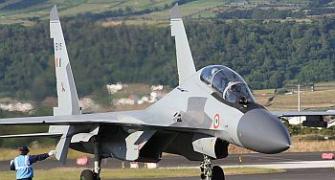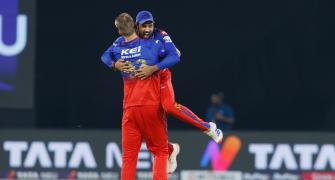 India's cumbersome arms procurement procedures and a plodding Ministry of Defence bureaucracy have long been blamed for shortfalls in combat capability. Now there is another, more worrying, reason - a growing crisis of funds, magnified by the lack of tri-service coordination.
India's cumbersome arms procurement procedures and a plodding Ministry of Defence bureaucracy have long been blamed for shortfalls in combat capability. Now there is another, more worrying, reason - a growing crisis of funds, magnified by the lack of tri-service coordination.
Slowing economic growth, coupled with a weak rupee, has left insufficient money for the military's ambitious modernisation programme. With no tri-service chief to coordinate and prioritise the needs of the army, air force and navy, their 15-year "long-term integrated perspective plan" is only an unaffordable wish list.
So dire is the shortfall, say senior ministry officials, that negotiations with vendors are dragged on, simply because there is insufficient money for new contracts. The capital budget (meant for new equipment) goes almost entirely on previous years' purchases, for which instalments are paid over five-10 years. This year, only Rs 2,955 crore of the military's capital budget of Rs 73,444 crore was available for new purchases.
Meanwhile, revenue expenditure rises as the army grows in size, even as pay commissions increase the cost of manpower. Last month, Rs 7,870 crore was transferred from the already stressed capital account to meet the burgeoning revenue expenditure.
In these circumstances, major acquisitions languish. These include the planned purchase of 145 M777 light guns from BAE Systems for a mountain strike corps on the Himalayan border. With no order, BAE Systems has halted its M777 assembly line in the US; the contract cost has risen from $647 million to a potential $885 million. Instead of raising the MSC in five years as planned, it will now be raised over eight years to spread its Rs 64,700-crore cost.
Also stuck in the pipeline are contracts with US company Boeing - for 22 AH-64 Apache attack helicopters and 12 CH-47F Chinook multi-mission helicopters, together worth some $2 billion; and a billion-dollar repeat order for four P-8I maritime aircraft to supplement the eight already bought. Delay is inevitable in the purchase of another 10 C-17 Globemaster III, worth $4 billion; as also in the $3-billion purchase of Honeywell engines to extend the service life of the Indian Air Force's 100-odd Jaguar fighters.
Seemingly impossible now is a contract for 126 Rafale medium multi-role combat aircraft. IAF would need to fork out Rs 15,000 crore as the 15 per cent signing amount, even at the lower end of Rafale's estimated price band of $16-20 billion.
Meanwhile, the weaponry bought this financial year - like the December 27 purchase of six C-130J Super Hercules transport aircraft for a billion dollars - will swell the "committed liabilities" for coming years, leaving a diminishing percentage for new purchases. If the Hercules are delivered over four years, MoD would need to pre-commit four annual instalments of Rs 1,560 crore each.
The proportion of pre-committed instalments has risen each year. In 2010-11, the capital budget allocated Rs 17,278 crore for new contracts and Rs 28,408 crore for "committed liabilities", or instalments due.
In 2011-12, there was Rs 9,467 crore for new contracts, while Rs 32,995 crore went on committed liabilities. Last year, the money for new contracts dropped to Rs 5,520 crore, with Rs 54,840 crore pre-allocated for instalments. This year, there is just Rs 2,955 crore for new contracts, while Rs 64,680 crore is pre-committed. Next year, without a sharp raise in the defence budget, there may be nothing for new contracts.
This crisis has been predictable in the absence of a tri-service commander to coordinate army, air force and navy spending. Each year, budgetary figures show no correlation between planning and expenditure. In 2011-12, the military asked for a capital allocation of Rs 88,680 crore; the government allocated far less, and the military eventually spent just 59 per cent of what it had projected. Last year, capital expenditure was just 63 per cent of the Rs 93,828 crore the military had asked for. This year, the military will spend a mere 58 per cent of the projected requirement of Rs 1,23,911 crore.
Former army vice-chief, Lieutenant General Shantanu Chaudhary, says appointing a tri-service chief is essential for easing the pressure on military budgets, both capital and revenue. A permanent chairman of the chiefs of staff committee, which the Naresh Chandra Task Force recommended to the prime minister last year, will rationalise the roles and capabilities of the three services, many of which are wastefully duplicated today.
Expenditure could be reduced and efficiency increased by getting the army, navy and air force to share infrastructure, logistics, command systems and even platforms. He cites multiple examples of needless duplication - electronic warfare capabilities created by all three services; complex command, control and intelligence networks that each service has created separately, instead of a common platform; and separate surveillance systems that result in thrice the expense and half the efficacy.
"The three services essentially look out for themselves. The senior-most service chief, who is the ex-officio chairman of COSC, naturally looks out for his own service rather than the tri-service good. Sensible modernisation demands a tri-service chief, who can prioritise procurement, plan budgeting and slash the duplication and triplication," says Chaudhary.










